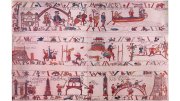The 950-year-old Bayeux Tapestry ranks among the world’s great art treasures. An astonishing 230 feet long and 20 inches high, it depicts 58 scenes from the years 1064-66, culminating in the Norman victory of William the Conqueror over English King Harold II at the Battle of Hastings in 1066. “It’s the first movie storyboard, cartoon strip, graphic novel, or coffee-table book,” says media lawyer Eric Rayman ’73, who viewed the actual tapestry decades after he first encountered it in parody form.
That was on the Harvard Lampoon cover of November 19, 1966. Artist David C.K. McClelland ’69 had created a two-panel “Bayeux Travesty” illustration that wrapped around the magazine’s front and back covers. Concurrent with the Lampoon’s observance of the 900th anniversary of the Battle of Hastings, it’s a closely rendered reimagining of the tapestry, updated to tell a saga of the Harvard-Yale football game instead of the Norman conquest. It is surely the most storied Lampoon cover ever.
The Bayeux Travesty is meticulously faithful to the original in colors, design, and its Romanesque style. “His calligraphy was letter-perfect,” says historian Ted Widmer ’84, Ph.D. ’93, a Lampoon alumnus like Rayman. “Among many other things, David was a medievalist who loved illuminated manuscripts.” The artist’s wicked wit also inspired dog-Latin inscriptions that smuggled outright obscenities onto the magazine cover without a single peep of reader protest.
“David was a raging genius,” says another Lampoon graduate, author and New Yorker writer Ian Frazier ’73. “He knew all kinds of different things, like the Welsh-speaking town in Patagonia he visited one summer. When you go to Harvard, you hope you’ll meet people like him, but usually, you don’t. David did not disappoint.”
A new exhibition, “The Long Lives of Very Old Books,” at the Harry Ransom Center of the University of Texas at Austin (until December 30), features some of McClelland’s roguery in his own handwriting. It includes Concent of Scripture, a volume by Hugh Broughton published circa 1590 in London. The eminent Harvard librarian Philip Hofer ’21, M.B.A. ’23, a pillar of the Houghton Library and a good friend to McClelland, gave it to the younger man long ago. Hofer had acquired an intact volume as well as an altered copy in which some engraved pages had been replaced with blank sheets.
McClelland’s innate mischievousness apparently inspired him to fill those empty spaces with diary entries, written in an elegant hand. “He filled up the margins and the blank pages with a long diary about what his life was like around Harvard Square, including his artistic ambitions, his party-going, and his occasional amorous conquests,” says Widmer, a former rare-books librarian at Brown University. “On one hand, it’s a terrible mutilation of a rare book—but on the other, it’s quite interesting to read.” Somehow the volume found its way from McClelland to eBay, where a Texas librarian purchased it for the Ransom Center.
Between 1970 and 1974, Hofer also commissioned McClelland to create calligraphic manuscripts, 54 in all, using quotations ranging from Rumi to John Cage. At his death in 1984, Hofer bequeathed them to Houghton. Essays and scholarship on McClelland’s life and work will appear in a forthcoming issue of the Harvard Library Bulletin.
McClelland died at age 29 in 1976. Throughout adulthood, he suffered from bipolar disorder. In the mid 1970s, he lived in New York City, where he drew cartoons for National Lampoon and wrote for the New Yorker and for Sesame Street. During an acute depressive phase, at a party in a Manhattan high-rise, McClelland’s life came to a spectacular, tragic end when he ran at full speed to crash through a plate-glass window and fall to his death. Sadly, the young polymath might have been just getting started.









